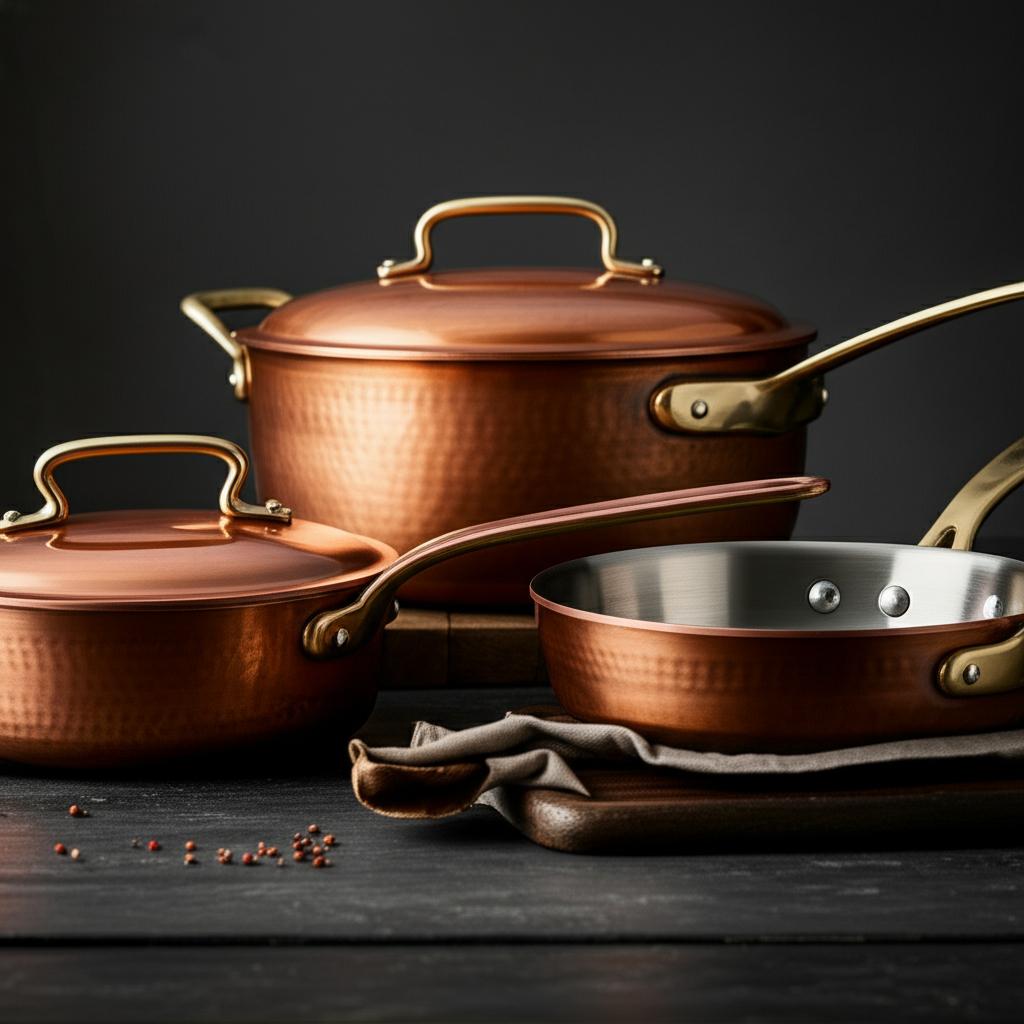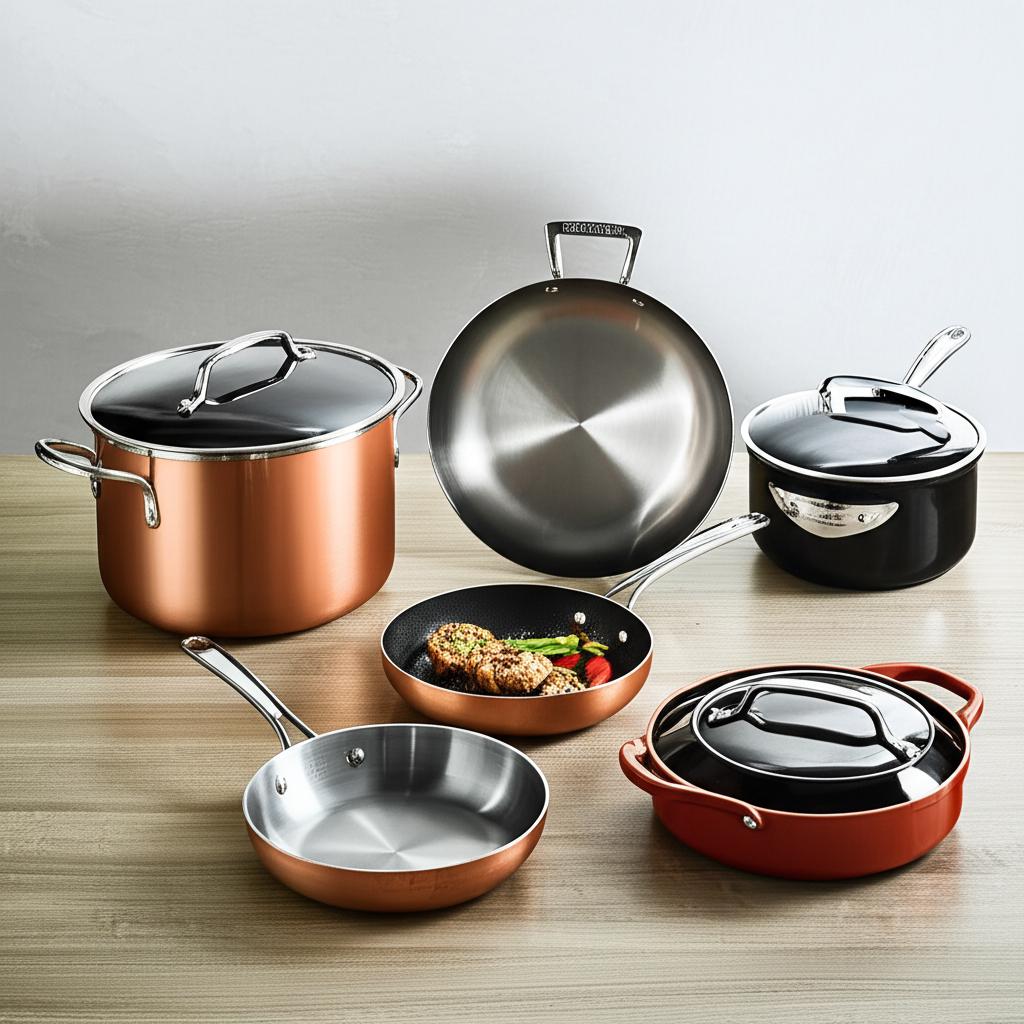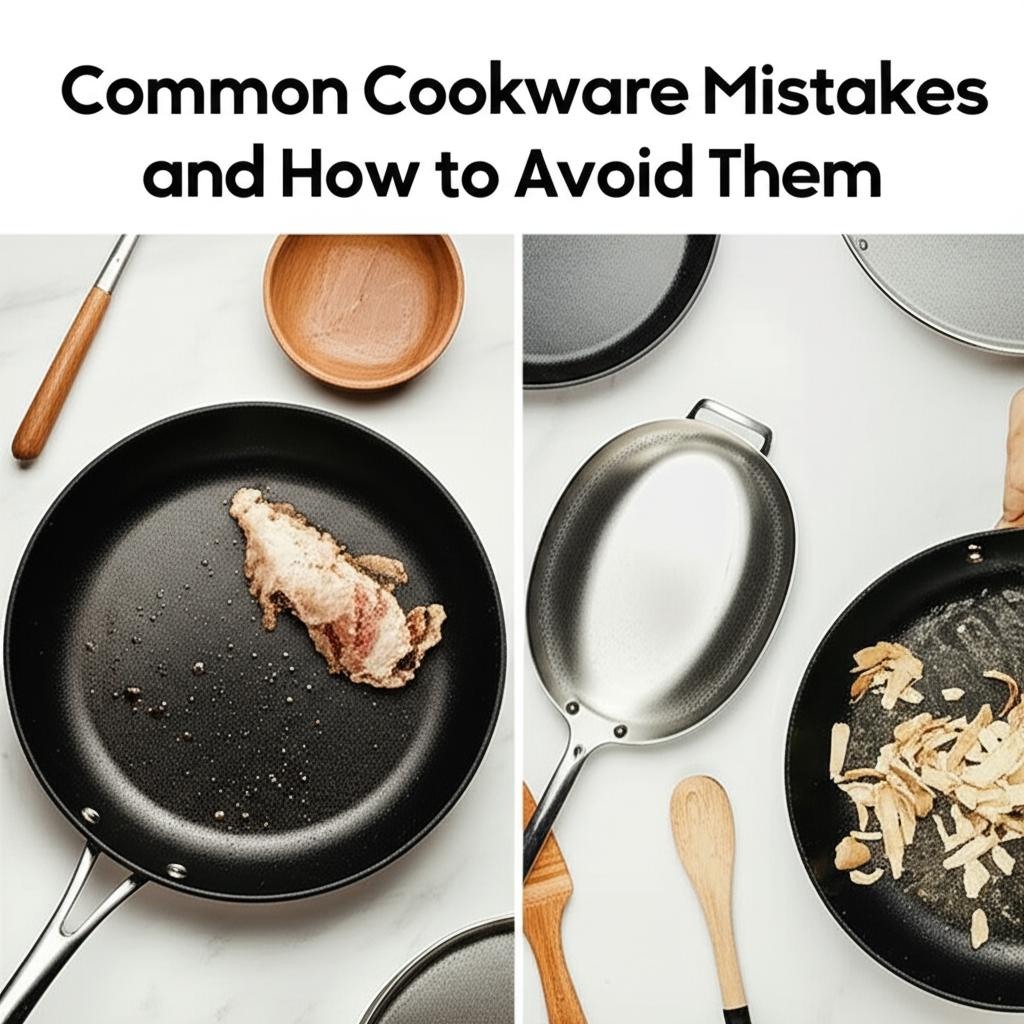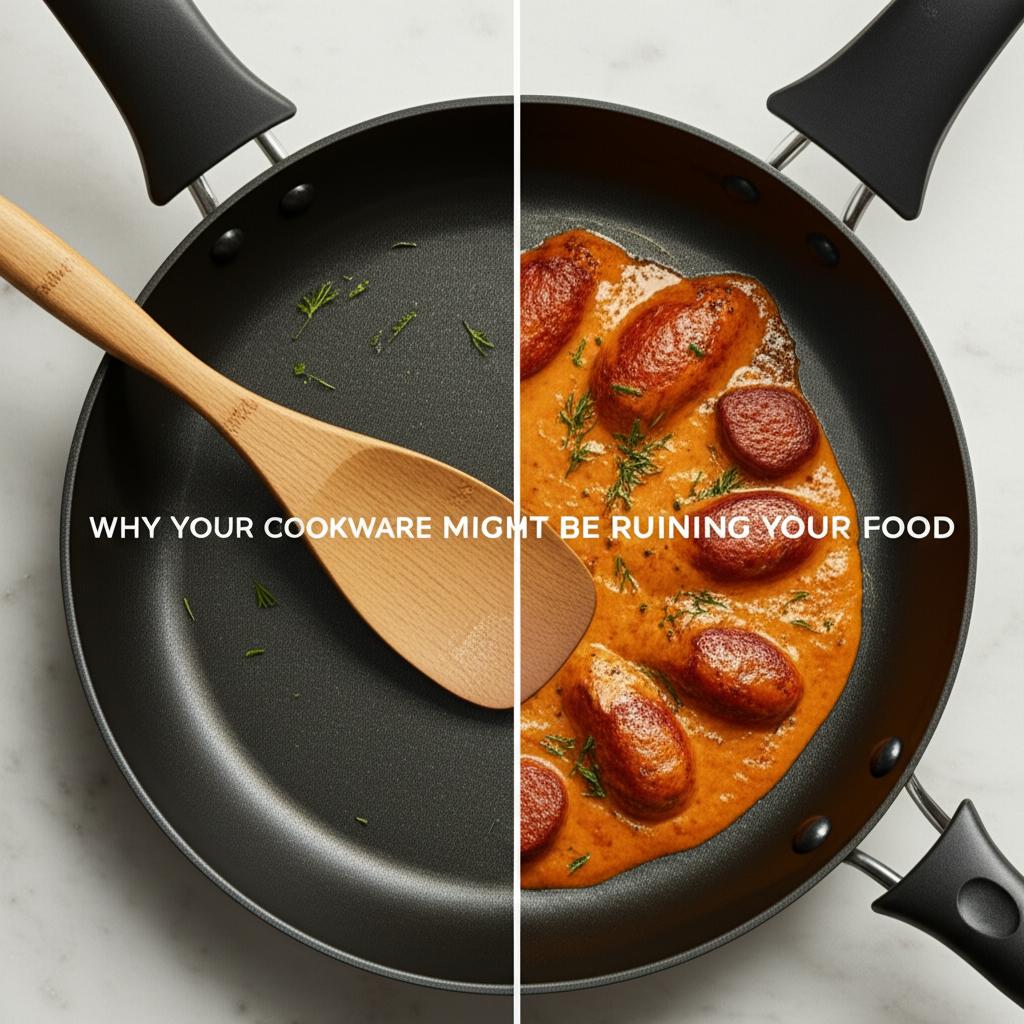
Cooking with Copper, Stainless, and Cast Iron: What Chefs Know About Their Pans
- BOSCH CO2159B 1-Piece 1/2 In. x 6 In. Cobalt M42 Metal Drill Bit with Three-Flat Shank for Drilling Applications in Stainless Steel, Cast Iron, Titanium, Light-Gauge Metal, Aluminum
- KOHLER K-8801-VS Duostrainer Sink Strainer, Fits Most Standard Kicthen Sinks, Vibrant Stainless
- 5-Burner Propane Gas Grill and Griddle Combo, Dual Zone Outdoor BBQ with 54,000 BTU 627 SQ.IN. Stainless Steel & Porcelain Cast Iron for Outdoor Cooking Kitchen, Garden, Patio Backyard Barbecue
Ever wonder why your favorite dish doesn’t quite taste the same as when a professional chef makes it? Beyond technique and ingredients, the cookware itself plays a starring role. Chefs understand that different materials bring unique properties to the stovetop, influencing everything from heat control to flavor development.
Today, we’re diving into the secrets of three kitchen powerhouses: copper, stainless steel, and cast iron. Forget product reviews; we’re focusing on the fundamental science and art of cooking with each material, giving you the chef’s edge right in your own kitchen. Let’s unlock the culinary potential of your pots and pans!
1. Copper Cookware: The Heat Maestro
Imagine a material so responsive that it reacts almost instantly to temperature changes. That’s copper. Revered for centuries, copper cookware is a top choice for tasks demanding absolute precision and control.
What Chefs Know About Copper:
Copper is an extraordinary conductor of heat. This means it heats up incredibly fast and, just as importantly, cools down almost immediately when removed from the heat. This responsiveness is its superpower. Most copper cookware is lined with a non-reactive metal like stainless steel or tin, as unlined copper can react with acidic foods.
Best Uses for Copper:
- Delicate Sauces: Think hollandaise, beurre blanc, or custards. The ability to precisely manage heat prevents scorching and breaking.
- Candy Making & Sugar Work: Achieving specific temperatures for caramel, toffee, or tempering chocolate is much easier.
- Reducing Liquids: Evaporating liquids uniformly without overcooking solids.
Cooking Tips for Copper:
- Start Low, Go Slow: While copper heats fast, it’s best to start with moderate heat and adjust upward. This helps you get a feel for its speed.
- Monitor Constantly: Due to its responsiveness, never leave an empty copper pan on high heat for long. It can quickly overheat and damage the lining or the pan itself.
- Adjust Heat Instinctively: Learn to make tiny adjustments to your burner, observing how quickly the copper pan reacts. This is the essence of cooking with copper.
Common Mistakes to Avoid with Copper:
- Overheating an Empty Pan: This is a big no-no. It can warp the pan or damage the tin or stainless steel lining.
- Using Unlined Copper for Acidic Foods: Unless specifically designed for it (like some jam pans), unlined copper can leach into acidic foods, imparting a metallic taste and potentially being harmful.
- Using Harsh Abrasives for Cleaning: Copper’s beautiful exterior can scratch easily. Stick to soft cloths and copper polish.
- Ignoring Discoloration: Copper naturally tarnishes. Regular cleaning and polishing not only keep it beautiful but also help maintain its even heating properties.
2. Stainless Steel: The Workhorse of the Kitchen
If copper is the finicky artist, stainless steel is the dependable, versatile workhorse. It might not boast copper’s conductivity, but modern stainless steel cookware, especially those with multi-ply construction (layers of aluminum or copper sandwiched between stainless steel), offer excellent performance and durability.
What Chefs Know About Stainless Steel:
Stainless steel is non-reactive, meaning it won’t leach metals into your food or react with acidic ingredients like tomatoes or wine. It’s also incredibly durable and easy to clean. Its layered construction ensures good, even heat distribution, preventing hot spots that can scorch food.
Best Uses for Stainless Steel:
- Searing and Browning: Achieving that perfect crust on meats and vegetables.
- Deglazing: The fond (browned bits) that stick to the bottom of a properly seared stainless steel pan are pure flavor! Deglazing with wine or stock is easy and effective.
- Sauce Making: Excellent for sauces that require simmering and reduction, where non-reactivity is key.
- Everyday Cooking: From sautéing to boiling, it’s your go-to for most tasks.
Cooking Tips for Stainless Steel:
- Preheat Properly: This is THE most important tip for stainless steel. Place your pan over medium heat and let it preheat for 2-4 minutes. A good test: Flick a few drops of water into the pan. If they dance and form beads (the Leidenfrost effect), it’s ready. If they just evaporate, it’s not hot enough. If they immediately sizzle away, it’s too hot.
- Use Enough Fat: Once preheated, add your oil or butter. It should shimmer but not smoke. The combination of proper preheating and fat creates a naturally non-stick surface.
- Don’t Overcrowd the Pan: Overcrowding lowers the pan’s temperature, leading to steaming instead of browning. Cook in batches if necessary.
- Embrace the Fond: Those browned bits on the bottom are flavor gold. After cooking, deglaze with a liquid (wine, stock, water) to release them and create an incredible sauce.
Common Mistakes to Avoid with Stainless Steel:
- Not Preheating Enough: This leads to food sticking, uneven cooking, and a frustrating experience.
- Using Too High Heat Initially: This can burn food quickly on the surface before it’s cooked through, and also make food stick.
- Overcrowding: Leads to soggy, steamed food instead of nicely browned dishes.
- Throwing Away the Fond: Don’t scrub away those flavorful bits! Use them for a pan sauce.
3. Cast Iron: The Legacy Pan
Cast iron is often described as a pan with a soul. It’s heavy, robust, and seemingly indestructible. More than just a cooking vessel, it’s often a cherished heirloom, passed down through generations – and for good reason.
What Chefs Know About Cast Iron:
Cast iron is famous for its exceptional heat retention. Once hot, it stays hot, making it ideal for maintaining consistent temperatures. It heats more slowly than copper or stainless steel, but once it gets there, it delivers unmatched searing power and creates an incredible non-stick surface through a process called “seasoning.”
Best Uses for Cast Iron:
- Searing Meats: Achieving a perfect, crispy crust on steaks, chicken, or pork.
- Deep Frying: The consistent heat retention keeps oil temperatures stable for perfectly crispy fried foods.
- Baking: Cornbread, biscuits, or even pizzas come out with a superior crust.
- Oven-to-Stovetop Dishes: Its oven-safe nature makes it incredibly versatile for dishes that start on the stove and finish in the oven.
Cooking Tips for Cast Iron:
- Preheat Slowly and Thoroughly: Due to its mass, cast iron needs time to heat evenly. Place it over medium-low heat for 5-10 minutes (or even longer for very large pans) before adding oil or food. This ensures even cooking and prevents sticking.
- Build and Maintain Seasoning: The “non-stick” quality of cast iron comes from layers of polymerized oil baked onto its surface.
- To Season: After cleaning, heat the pan on the stove to evaporate all moisture. Then, apply a very thin layer of high smoke point oil (like grapeseed or flaxseed) with a paper towel, wiping off any excess. Bake upside down in a hot oven (350-400°F / 175-200°C) for an hour, then let it cool in the oven. Repeat this process a few times for a good initial seasoning.
- After Each Use: A light coat of oil after cleaning helps maintain the seasoning.
- Use Appropriate Fats: For cooking, higher smoke point oils are great for general use, but butter or lower smoke point oils can be used once the pan is properly seasoned.
- Embrace the “Stick-Free” Crust: With proper preheating and seasoning, food will release easily, leaving behind a delicious, crispy exterior.
Common Mistakes to Avoid with Cast Iron:
- Not Preheating Long Enough: This is the #1 reason food sticks to cast iron. Patience is key.
- Washing with Harsh Soap (Traditional View): While modern cast iron can handle a little soap, traditional wisdom says to avoid it as it can strip seasoning. For most purposes, hot water and a stiff brush are sufficient. If you do use a tiny bit of soap, re-oil immediately.
- Not Drying Immediately: Water is cast iron’s enemy. After washing, dry thoroughly on the stove over low heat, then apply a thin layer of oil.
- Using for Highly Acidic Foods (Long Cook Times): Simmering acidic foods (like tomato sauce) for extended periods can strip the seasoning, causing a metallic taste and potentially rusting the pan. Quick sautés are usually fine.
- Storing While Damp: This will lead to rust. Always ensure it’s completely dry and lightly oiled before storing.
Mastering Your Kitchen’s Tools
Understanding the unique properties of copper, stainless steel, and cast iron empowers you to choose the right tool for the job, just like a chef.
- For precision and responsiveness, reach for copper.
- For versatility, durability, and perfect browning, grab your stainless steel.
- For incredible searing, consistent heat retention, and a rustic charm, embrace your cast iron.
Each material brings its own strengths to the table, and knowing when and how to use them will elevate your cooking from good to gourmet. So, next time you step into the kitchen, think like a chef, choose your weapon wisely, and get ready to create something delicious!
- BOSCH CO2159B 1-Piece 1/2 In. x 6 In. Cobalt M42 Metal Drill Bit with Three-Flat Shank for Drilling Applications in Stainless Steel, Cast Iron, Titanium, Light-Gauge Metal, Aluminum
- KOHLER K-8801-VS Duostrainer Sink Strainer, Fits Most Standard Kicthen Sinks, Vibrant Stainless
- 5-Burner Propane Gas Grill and Griddle Combo, Dual Zone Outdoor BBQ with 54,000 BTU 627 SQ.IN. Stainless Steel & Porcelain Cast Iron for Outdoor Cooking Kitchen, Garden, Patio Backyard Barbecue
FAQ
Q. What are the primary heat management differences between copper, stainless steel, and cast iron, and why do chefs care?
A. Chefs prioritize heat management for precise cooking. Copper offers exceptional thermal conductivity, heating up and cooling down very rapidly and evenly, allowing for precise temperature control, crucial for delicate sauces or candy making. Stainless steel is a poor conductor of heat on its own, but when clad with aluminum or copper layers, it achieves good even heating and heat retention, offering stability. Cast iron heats slowly but retains heat incredibly well and evenly once hot, making it ideal for searing, frying, and long, slow braises where consistent high heat is needed.
Q. Is cooking with copper safe, given its reactivity, and how do chefs mitigate this?
A. Yes, modern copper cookware is safe because it’s almost always lined with a non-reactive metal, typically tin or stainless steel. Unlined copper can react with acidic foods, leaching copper into the food, which can be toxic in large amounts or impart a metallic taste. Chefs ensure their copper pans have intact linings. Unlined copper is usually reserved for non-acidic tasks like whisking egg whites or making jams where a specific reaction is desired, or for decorative purposes.
Q. When would a chef consistently choose stainless steel over cast iron or copper?
A. Chefs choose stainless steel for its versatility, durability, and ease of maintenance. It’s non-reactive, meaning it won’t leach metals into food or affect flavor, making it suitable for all types of ingredients, especially acidic ones. Its robust construction withstands high-volume use and aggressive cleaning, and it’s often dishwasher-safe. While not the best for searing or delicate temperature control (unless clad), it’s the workhorse for general-purpose cooking, boiling, sautéing, and saucing in a professional kitchen.
Q. What’s the secret to properly maintaining cast iron for professional results, especially concerning seasoning?
A. The secret to professional cast iron maintenance lies in consistent seasoning and proper cleaning. Seasoning is a polymerized oil layer that provides a natural non-stick surface and rust protection. Chefs achieve this by heating a thin layer of high smoke-point oil (like flaxseed or grapeseed) onto the pan repeatedly. After use, they clean it immediately with hot water and a stiff brush (avoiding harsh soap to preserve seasoning), dry thoroughly on the stovetop, and apply a very thin layer of oil before storing. This meticulous care ensures a perfectly non-stick, rust-free surface that improves with age.
Q. Are there specific cooking tasks where each material truly excels and is preferred by chefs?
A. Absolutely. Copper excels in temperature-sensitive tasks like making delicate sauces (hollandaise, beurre blanc), custards, caramel, or candy, where rapid and precise heat adjustments are critical. Cast iron is unmatched for high-heat searing (steaks, chops), achieving perfect crusts (cornbread, frittatas), deep frying, and slow-cooking dishes due to its exceptional heat retention. Stainless steel, particularly clad, is the go-to for general sautéing, simmering, boiling, making pan sauces, and any task involving acidic ingredients, offering reliability and durability across a wide range of kitchen operations.
Q. Beyond heat properties, what other factors influence a chef’s choice of cookware material for specific tasks?
A. Chefs consider weight, maneuverability, and durability. Copper, while excellent for heat, can be heavy and requires careful handling to protect its lining. Stainless steel offers a good balance of weight and robustness, suitable for tossing ingredients or busy line work. Cast iron is extremely heavy, making it less ideal for frequent lifting or quick pan flips, but its heft contributes to its stability and heat retention for static cooking tasks like oven baking or long braises. Cleaning ease and reactivity are also major factors, as previously discussed, influencing which pan is grabbed for a particular dish.


